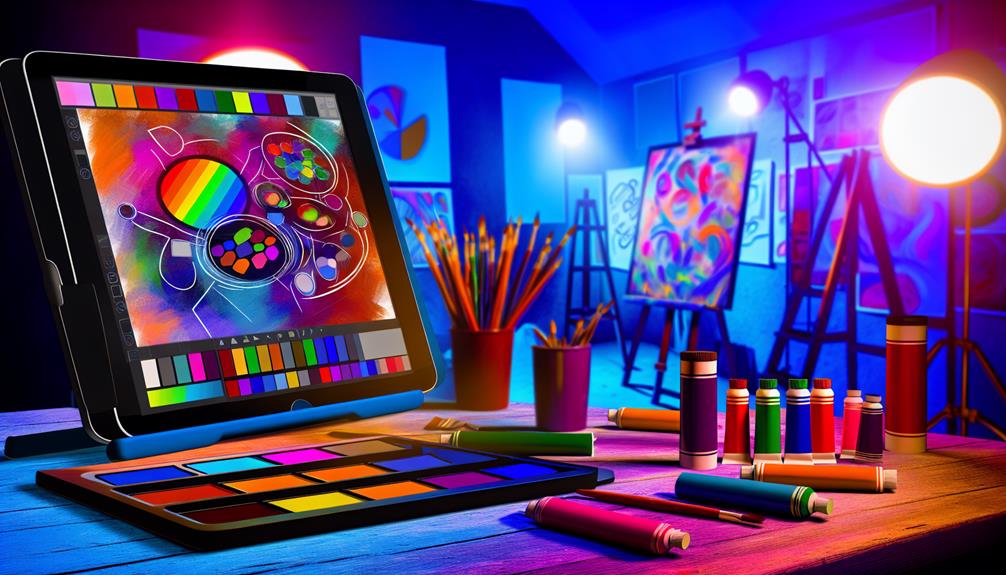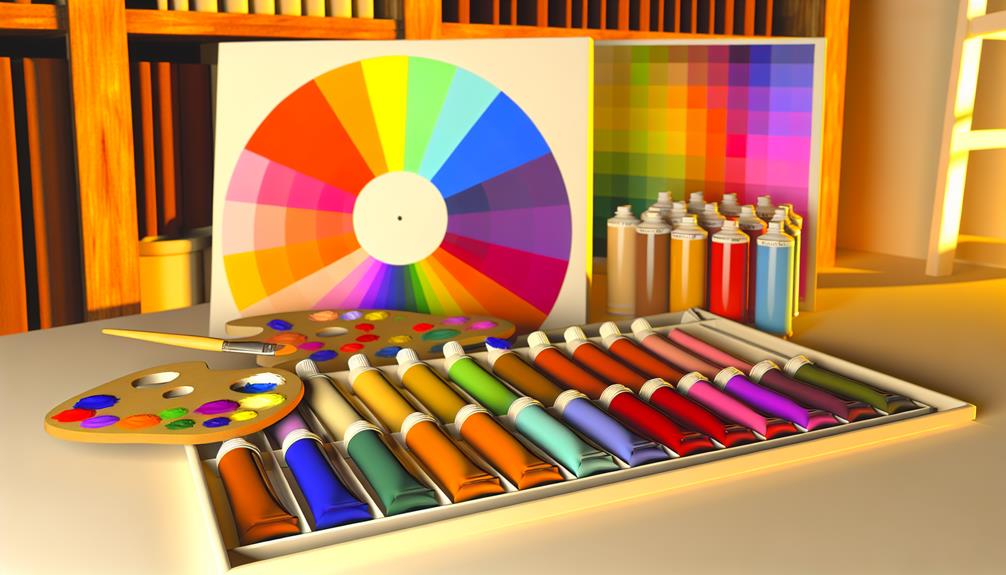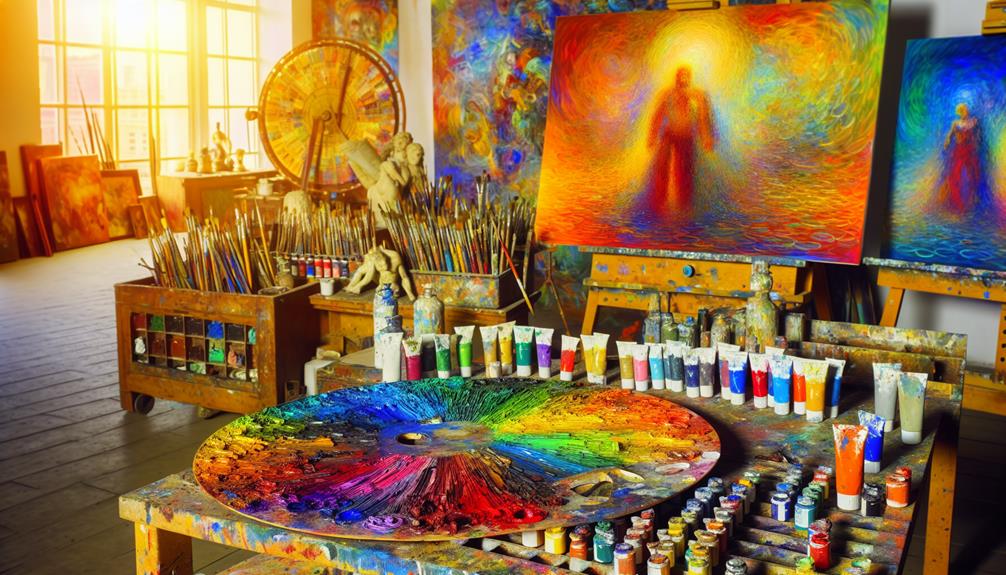To master custom color creation like a pro, you need a solid grasp of color theory and the right tools. Start with high-quality pigments and essentials like palettes and brushes. Mix primary colors to form vibrant secondaries, then create tertiary colors for depth. Experiment with shades and tints by adding white or black to adjust mood and intensity. Document your mixing ratios for consistency, and use color harmonies—like complementary or monochromatic schemes—to enhance your designs. With each technique, you'll reveal the emotional power of color. To truly elevate your skills, explore the art of application and troubleshooting common issues.
Key Takeaways
- Understand color theory to create impactful designs and emotional connections using color associations and harmonies.
- Utilize high-quality pigments and precise mixing tools to achieve vibrant and consistent custom colors.
- Experiment with shades and tints by adding black or white to create depth and complexity in your artwork.
- Apply color harmonies effectively, using techniques like complementary or analogous colors to evoke specific feelings and enhance visual appeal.
- Document your color mixing processes and create a swatch book for easy reference and consistency in future projects.
Understanding Color Theory

Understanding Color Theory
Grasping the fundamentals of color theory can elevate your design skills to new heights. It's not just about picking pretty shades; it's about understanding how colors interact and influence emotions. Sephora's stance on support for international issues reflects the importance of aligning brand values with audience sentiments. Color psychology plays a vital role in your design choices. For instance, warm tones like red and orange evoke energy and passion, while cooler hues like blue and green impart calmness and serenity. Knowing these associations can help you create a more impactful message through your work.
Equally important is color symbolism. Different cultures and contexts assign unique meanings to colors. For example, white often symbolizes purity in Western cultures, while in some Eastern traditions, it represents mourning. By integrating this knowledge into your designs, you can connect more deeply with your audience, making your work resonate on a personal level.
As you dive deeper into color theory, consider how each shade can tell a story or evoke a feeling. Embrace experimentation; let colors guide your creativity. Remember, the right palette can transform not just your project, but the emotions it stirs in those who experience it. So, don't just choose colors—understand them.
Essential Tools and Materials
Choosing the right tools and materials is essential for bringing your color visions to life. First, invest in quality color mixing tools—think palette knives, mixing trays, and even glass plates. These aren't just functional; they help you control the blending process, ensuring precision in your desired outcome. A sturdy mixing palette can keep your workspace organized while you experiment with hues. Additionally, consider how you might benefit from unlocking membership perks that could support your artistic journey.
Next, focus on pigment selection. Whether you're drawn to acrylics, watercolors, or oils, choose high-quality pigments that offer depth and vibrancy. Look for brands that provide transparency ratings, as this will help you understand how colors will interact when layered. Don't shy away from experimenting with different media; each brings a unique texture and finish.
Additionally, gather measuring tools, like droppers and scales, to maintain consistency when recreating your custom colors. Remember, the right tools and materials can elevate your craft, allowing you to express your creativity authentically. Surround yourself with these essentials, and you'll belong to a community of makers who share your passion for color innovation. Embrace the journey, and let your imagination flourish!
Mixing Primary Colors

When it comes to mixing primary colors, you'll find that understanding the relationships between them can open a world of possibilities in your artwork. Just like Paul Hogan's journey from humble beginnings to global fame, mastering these color blending techniques not only enhances your skills but also fosters a sense of belonging in the artistic community the rise to fame.
To start, let's explore the vibrant primary color combinations you can create:
- Red and Yellow: A warm, energetic orange that ignites passion.
- Blue and Yellow: A rejuvenating green that evokes tranquility.
- Red and Blue: A bold purple that inspires creativity.
- Intensity: Adjusting the ratio can yield subtle variations that resonate with your mood.
- Layering: Transparent mixes can create depth and intrigue in your work.
As you experiment with these combinations, remember that each blend tells a story. Whether you're painting a landscape or crafting an abstract piece, the emotions tied to these colors can deepen your connection to your art. Embrace the magic of primary colors and let your creativity flourish, knowing that you're part of a vibrant community of artists exploring and celebrating color together.
Creating Secondary and Tertiary Colors
To master custom colors, you need to grasp the fundamentals of color theory and how primary colors blend to create vibrant secondary and tertiary hues. By employing specific mixing techniques, you can manipulate these colors to suit your creative vision. Let's explore how these principles translate into practical applications, enhancing your color palette like a pro.
Understanding Color Theory
Understanding color theory is essential for anyone looking to create vibrant and harmonious designs, and it often begins with the interplay of primary colors. By mixing these foundational shades, you'll discover secondary colors like orange, green, and purple, and as you push further, you'll create tertiary colors that add depth and nuance to your palette.
Emotional connections to colors arise from their meanings and perceptions. Here are a few aspects to reflect on:
- Color psychology: How colors influence emotions and behaviors.
- Color symbolism: The cultural meanings behind different hues.
- Color temperature: Warm vs. cool colors and their impact on mood.
- Color contrast: Enhancing visual appeal through opposing colors.
- Color trends: Staying updated on what's resonating with your audience.
Understanding these elements helps you navigate color context and make informed choices that reflect current trends. Each color carries its own message, shaping the viewer's experience. By embracing these concepts, you cultivate a sense of belonging within a community that values expressive, intentional design. Immerse yourself in color theory and watch your creative work flourish as you master the art of color meanings!
Mixing Techniques Explained
In the world of color mixing, mastering the techniques for creating secondary and tertiary colors opens up a domain of creative possibilities. By combining primary colors—red, blue, and yellow—you can form vibrant secondary colors. Mix equal parts of red and blue, and you'll get a rich purple; blend yellow and blue for a bright green; and combine red and yellow to create a warm orange.
Once you've grasped the basics, explore blending techniques to create tertiary colors. This involves mixing a primary color with a neighboring secondary color on the color wheel. For instance, mixing yellow with green yields a fresh yellow-green, while red with orange produces a fiery red-orange.
Experimenting with ratios will help you find unique shades that resonate with your artistic vision. Remember, color mixing is as much about intuition as it is about technique. Don't hesitate to make adjustments as you go, allowing your colors to evolve organically. Embrace the process, and you'll find yourself developing a palette that feels distinctly yours, enriching your creative journey and building a stronger sense of belonging within your artistic community.
Practical Color Application
While experimenting with color mixing, you'll quickly discover how practical applications of secondary and tertiary colors can elevate your artwork. These colors not only enhance your palette but also tap into deep emotional resonances through color psychology and symbolism. By understanding their roles, you can create art that speaks to viewers on a profound level.
To harness the power of secondary and tertiary colors effectively, consider these key aspects:
- Harmony: Combine colors to create a unified and engaging composition.
- Contrast: Use opposing colors to draw attention and evoke excitement.
- Mood: Different colors can trigger specific emotions, influencing your audience's experience.
- Depth: Layering colors adds dimension, making your artwork more dynamic.
- Narrative: Each color tells a story; choose wisely to convey your message.
Using Color Harmonies

To create a visually striking palette, you'll want to grasp the fundamentals of color theory and how different hues interact. By exploring the various types of color harmonies, you can transform your designs from ordinary to extraordinary. Let's look at practical applications that will help you master these concepts and bring your creative vision to life.
Understanding Color Theory
Color theory is the backbone of effective design, and understanding color harmonies can elevate your work from ordinary to extraordinary. When you grasp the principles of color psychology and color symbolism, you reveal a powerful toolset for connecting with your audience on a deeper level.
Here are some key emotional impacts colors can evoke:
- Red: Passion and energy that ignites excitement.
- Blue: Trust and calmness, fostering a sense of security.
- Green: Growth and harmony, creating a feeling of renewal.
- Yellow: Joy and optimism, inspiring creativity.
- Purple: Luxury and wisdom, appealing to a sense of sophistication.
Types of Color Harmonies
Understanding how colors interact is essential for creating visually appealing designs, and this is where color harmonies come into play. By mastering different types of color harmonies, you can create harmonious designs that resonate with your audience.
Complementary colors, which sit opposite each other on the color wheel, create striking contrasts that draw attention. Triadic schemes, featuring three colors evenly spaced around the wheel, offer balance and vibrancy. On the softer side, monochromatic palettes use variations of a single hue, evoking a sense of unity and calm.
Analogous pairings, using colors next to each other, produce soothing effects, while split complementary combos provide a dynamic twist by combining one color with two adjacent to its complement, enhancing depth. Tetradic combinations, which consist of two complementary color pairs, allow for rich, complex designs that convey strong color temperature and symbolism.
Each scheme carries its own color contrast and emotional resonance, so choose wisely to align with your design's purpose. By exploring these color harmonies, you'll not only enhance your designs but also foster a deeper connection with those who experience them.
Practical Application Examples
When you're ready to apply color harmonies in your designs, real-world examples can illuminate their potential. By leveraging custom color palettes, you can create impactful works that resonate with your audience, overcoming those pesky color mixing challenges. Here's how you can use different color harmonies to evoke specific emotions:
- Analogous Colors: Create a calming atmosphere that fosters unity and belonging.
- Complementary Colors: Generate excitement and energy, perfect for a dynamic advertising campaign.
- Triadic Colors: Establish a balanced vibrancy, ideal for playful and engaging children's products.
- Monochromatic Schemes: Convey sophistication and elegance, suitable for luxury branding.
- Split-Complementary: Achieve striking contrast while maintaining harmony, great for creative portfolios.
Each of these approaches can make your designs stand out and connect with viewers on a deeper level. By understanding and experimenting with these color harmonies, you're not just solving color mixing challenges; you're crafting visual stories that invite others to feel a part of your creative vision. Embrace these examples, and watch your designs transform into expressions of emotion and connection.
Experimenting With Shades and Tints
Exploring shades and tints can transform your creative palette into a vibrant masterpiece. It's about diving into the nuances of color, where shade variations and tint adjustments open up new avenues for expression. When you add black to a color, you create deeper, richer shades that evoke feelings of drama and intensity. Think about the mood you want to convey; a darker hue can add depth, while lighter tints can evoke softness and warmth.
To experiment effectively, start with a base color you love. Gradually mix in white for tint adjustments, observing how it alters the character of your original hue. Don't hesitate to create a range of tints—this can lead to surprising combinations that resonate with your vision. Likewise, play with shade variations by introducing black, giving your palette a sophisticated complexity.
As you mix, take notes on what works and what doesn't. This isn't just about color; it's about discovering your unique voice in the art world. When you embrace these techniques, you'll find yourself not just creating colors, but crafting an emotional journey that invites others to join in your artistic adventure.
Digital Color Mixing Techniques

In the domain of digital art, your screen becomes a canvas where color mixing takes on new dimensions and possibilities. With the right techniques, you can create stunning, custom colors that resonate with viewers. Understanding digital palettes and color psychology is essential in this creative journey.
Here are some key techniques to enhance your digital mixing:
- Layering – Blend colors in layers to add depth and richness.
- Opacity – Adjust the opacity of each layer to control how colors interact.
- Color Wheel – Use the color wheel to find harmonious combinations.
- Blending Modes – Experiment with different blending modes for unique effects.
- Sampling – Use eye dropper tools to sample colors from existing artwork for inspiration.
Practical Applications in Crafting
Custom colors aren't just for digital art; they play a significant role in crafting as well. When you're creating handmade items, the colors you choose can evoke emotions and tell stories. Think about how different shades of blue can symbolize calmness, while vibrant reds might ignite passion or excitement. By understanding color symbolism, you can infuse your creations with deeper meaning, making them not just visually appealing but emotionally resonant.
Imagine crafting a cozy blanket in soft earth tones that evoke warmth and connection, perfect for a gift to a loved one. Or picture a striking piece of jewelry featuring bold colors that reflect the personality of the wearer. The emotional impact of your chosen hues can transform ordinary projects into cherished keepsakes.
Incorporating custom colors into your crafting process allows you to express your unique style and connect with others on a profound level. Whether you're painting, knitting, or designing, remember that every color choice contributes to the narrative you're weaving. So, immerse yourself in your palette, experiment with shades, and let your creativity flourish. You'll find that color isn't just an aesthetic choice; it's a powerful tool in crafting meaningful connections.
Tips for Color Consistency

Achieving color consistency is crucial for bringing your crafting visions to life. It's all about creating a harmonious palette that resonates with your audience and elevates your work. Here are some tips to help you maintain that essential consistency:
- Create a Color Swatch: Keep a well-organized color swatch book to reference your custom colors.
- Use Color Matching Techniques: Always match your colors against the swatch to guarantee they're true to your original vision.
- Mix in Controlled Environments: Light and surface can alter how colors appear, so mix in similar settings.
- Document Your Formulas: Write down the exact ratios of your colors; this way, you can recreate them easily.
- Test, Test, Test: Before committing to a large project, test your colors on scraps to see how they hold up.
Frequently Asked Questions
How Do I Choose a Color Palette for My Project?
Choosing a color palette for your project can be exciting yet challenging. Start by considering color theory; it can guide you in selecting hues that harmonize beautifully. Think about the mood you want to convey—warm colors evoke energy, while cool tones inspire calm. You'll want your palette to resonate with your audience, inviting them to feel connected. Experiment with combinations, and don't hesitate to trust your instincts; they often lead to the best results.
What Are the Best Practices for Storing Mixed Colors?
When you're mixing colors, storing them properly is crucial for maintaining their vibrancy. Consider using airtight storage container options, like glass jars or squeeze bottles, to minimize exposure to air. Employ color preservation techniques such as adding a few drops of a preservative medium. Label each container with details about the mix to guarantee you can recreate it later. This careful approach not only protects your work but also fosters a sense of belonging in your creative community.
How Can Lighting Affect Color Perception in My Craft?
Lighting plays a vital role in how you perceive color. Different color temperatures can dramatically alter the appearance of your mixed hues. For instance, warm ambient light can make colors appear richer and more vibrant, while cool light might wash them out. It's important to take into account your workspace's light source, as it can influence your creative decisions. Experimenting under various lighting conditions helps you understand how your colors truly shine, fostering a deeper connection with your craft.
Can I Mix Colors From Different Mediums Together?
You can mix colors from different mediums, but it's crucial to take into account medium compatibility. For instance, acrylics might not blend well with oils due to their differing bases. When using color mixing techniques, experiment with small amounts first. Create a harmonious palette by understanding how each medium interacts. Don't hesitate to explore; your unique combinations can lead to stunning results that truly reflect your artistic voice and vision. Embrace the journey!
How Do I Troubleshoot Muddy or Dull Colors?
When you're dealing with muddy or dull colors, it's crucial to revisit your color theory and mixing techniques. Start by analyzing your palette—are you unintentionally blending complementary colors? This can create that muddy effect. Instead, try using analogous colors to maintain harmony. Also, make certain you're using clean brushes and tools to avoid contamination. Experiment with varying proportions; sometimes, a touch more of a vibrant hue can bring your mix back to life!

